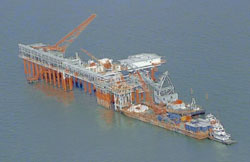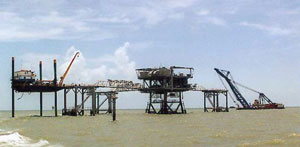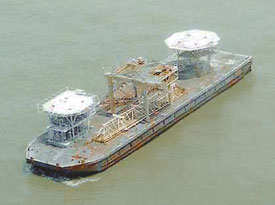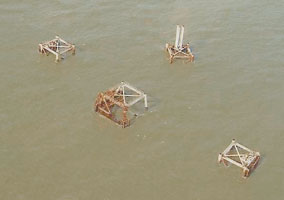Meeting today's plug & abandonment/ decommissioning demands
MANAGEMENTMeeting today’s plug & abandonment / decommissioning demandsLacking the basic skills and manpower to handle the legal and physical complexities of abandoning an offshore facility, working with a company specifically skilled in such practices on a turnkey basis can be a win/win situationRichard Dodson, President, Tetra Applied Technologies, Inc., a wholly owned subsidiary of Tetra Technologies, Inc., The Woodlands, Texas
Along with this pressure comes the basic economic fact that, until recently, P&A has been a backdoor issue. Historically not generating revenue, P&A typically represents the end of the road for decades of production that has dwindled to the point that it is time to plug the well(s). Because of P&A’s position in the production life cycle, there may not be a high awareness level in the industry about balance sheet liabilities, the impact of environmental regulations, adherence to safety, and how remaining reserves can actually be milked while abating liability. In fact, since P&A operates outside E&P for practical purposes, general knowledge of how the process works is not widely shared information. Therefore, this article explores how it works, how major issues are being solved, and how the changing face of abandoning wells is bringing value to oil and gas companies. Plug & Abandonment Profile Greatly simplified, P&A is essentially a five-step process, following project engineering and cost assessment. First is federal and state regulatory permitting for structural / platform removals, pipeline abandonments, well P&As, site clearance verification and final project completion reports. Second, wells must be plugged and the facility must be prepared. That includes flushing and cleaning process components and preparing the platform, or structure, for removal. In the third stage, pipeline abandonment gets underway, initially with pigging and/or flushing (riser to riser, and riser to subsea tie-in).
That is followed by cutting, plugging, burying or removal. Actual removal begins with divers severing components with explosives, mechanical or grit. Heavy-lift vessels either bring the platform or structure ashore for recycling, sale or scrap; or the operator participates in a reefing program. Finally, in the fifth step, the site is cleared, which includes trawling or side-scan sonar on the seabed. Then site clearance is verified, and federal and state regulatory reporting is completed. The accompanying photos illustrate major components of actual P&A operations. Only recently has this process become a turnkey operation provided by certain companies, since the decommissioning industry is highly fragmented, with only a few companies having the financial strength and stability to take P&A cradle to grave. Those that do have such strength / stability have total package capabilities. In addition to the physical dismantling, they also function as the government interface; they can eliminate heavy manpower necessities required of oil and gas companies, and handle the project management of keeping all stages on-track and on-budget.
Revenue Drain Alternative How significant is the decommissioning issue, i.e., do the numbers justify concern toward approaching offshore platforms with a renewed emphasis? Consider that in the U.S. Federal Outer Continental Shelf (OCS), almost 4,000 platforms were in place as recently as five years ago. A sizeable percentage were about 25 years old. These do not even include the thousands of miles of pipelines. Since the late 1980s, more than 100 platforms have been removed annually from the Gulf of Mexico, where associated costs, as with E&P, are dramatically higher than onshore. Abandonment costs per platform, by some estimates, range from $300,000 to $13 million – the deeper the water, the higher the costs. All of these factors can result in the curious dilemma of some leases’ net worth being negative, even if generating positive cash flow, i.e., more liability than remaining reserves. Yet, however uncomfortable decommissioning may be, "walk off and leave" is not a regulatory option concerning abandonment. Minerals Management Service (MMS) regulations mandate that wells must be abandoned within a specific timeframe and in a specific manner. Environmental / Financial Liability Amid the liability and cost factors swirling around abandonment, environmental protection is no small matter. Hydrocarbon zones must be isolated downhole, freshwater aquifers must be protected and formation fluids must not be allowed to migrate. But, regulations extend beyond the water and seabed to encompass the Endangered Species Act and the Marine Mammal Protection Act. Therefore, not only must considerable planning and detailed execution go into disposition of a platform, the operator must verify that the cleanup is complete. The lease must be sonar side-scanned, or the company must manually verify that no debris remains on the seabed. In relatively shallow depths, that is not particularly complicated or costly. However, as depth increases, as with other offshore costs, so does the expense of meeting environmental regulations currently in place. Regarding financial liability, for all the complexities of platform abandonment, it is very clear-cut in one respect. The operator, upon drilling a well, is obligated from that point until it has fully complied with federal abandonment regulations. Consequently, offshore operators have had to demonstrate their financial responsibility, e.g., through insurability or bonding. In recent years, however, two key factors entered the picture. The MMS became concerned about smaller operators not being able to handle abandonment costs, which would force these costs onto the collective back of the MMS. And inflation had outpaced bonding requirements. Therefore, bonding requirements were increased to as high as $3 million. Waivers may be granted if certain size stipulations – which essentially verify that the company is large and financially stable – are met. Even assigning the property does not mean future liability is effectively transferred. The MMS, if not able to develop other liability alternatives in particular situations, may continue to hold the original operator liable in a lawsuit for not properly abandoning a well. While rules differ somewhat with state leases, and the governing authority shifts from federal to state agencies, the environmental issues are of equal concern, especially when it comes to the protection and future of our freshwater aquifers.
Safety Considering the components involved in successful platform abandonment – from structure preparation to severing components to heavy lifting – safety is a key concern. As with any industry endeavor, providing qualified personnel is imperative, yet a valid safety program must extend beyond that fundamental requirement. That includes having personnel with core competencies in all phases of the P&A process. A continuous-improvement safety program begins with effectively conforming to customer requirements. It must also:
While safety may seem fundamental, the need for constant interface and continued behavioral modification to improve all aspects of a program and the processes it serves will continue to be a top concern. P&A Trend With regulations mounting, adverse financial consequences always just around the corner, and a fragmented abandonment industry as the standard for platform decommissioning, a trend began emerging to build an improved win/win scenario. This new trend centers on an old term – turnkey – responding to the logical idea of integrating all facets of P&A/decommissioning under one corporate umbrella. By turnkeying the operation, execution of the various stages could be streamlined, a more cohesive safety and environmental program could be employed, and platform removal costs could be reduced. The proven fact is that no company with offshore platforms considers abandonment a core competency. By offering these companies the ability to outsource abandonment, they can focus more directly on exploration and production (E&P). Traditionally, offshore companies would postpone any planning for abandonment, then attempt to pull the disparate process together at the eleventh hour. Case History: Win/Win With the financial strength and resources a P&A company brings to the table, win/win situations can arise that go beyond an oil company solely taking a platform out of commission. For example, an operator owned a field that produced to one of the Gulf of Mexico’s great oil producing fields (about 1 Tcf gas). The oil company’s field was shut-in, primarily because it flowed to an old platform that was in a state of disrepair and scheduled to be decommissioned. The turnkey P&A company entered into an agreement to P&A the old field, and the production division of the turnkey company purchased the adjoining field. Subsequently, the turnkey P&A company provided a platform from inventory that had been slated for recycling or re-use, to replace the old platform being decommissioned. They installed the platform, and production from the adjoining field will be restored. Meanwhile, the turnkey P&A company is plugging the wells on the old platform, and everyone wins. The production division got production, the decommissioner gets heavy lifting and well-plugging work, and some platform inventory was put back into use, which served the operator’s interests, in addition to divesting itself of an unwanted field. The Gulf of Mexico is safer and cleaner for the removal of decaying old platforms and potentially problematic old wells. At the same time, the turnkey P&A company’s production division is not in the business of competing in E&P with major or even mid-size oil companies, which must replace reserves on a much larger scale. Rather, this new business approach (or business model) provides a complementary service that allows these companies to abate their liability.
Dispose Of Liability Quickly / Efficiently With abandonments becoming as frequent as new installations, it has become important to reconsider the liability proposition of offshore platforms ending their production life-cycle. In the context of extensive federal regulations, including environment and safety, this issue is no small challenge, and it is highly logistical, paper-intensive and costly. For these reasons, it is imperative to recognize, first and foremost, that when production ends, the platform suddenly becomes a major financial liability that should be quickly disposed of. But, the process is complicated, and it is not within an oil company’s core competencies. Conclusion By developing new strategies for an old problem, efficiencies have been introduced that allow oil companies to dispense of the work, equipment and money involved in P&A/decommissioning. Never a routine operation, P&A, pipeline abandonment, platform abandonment and removal, and site clearance / verification require that wide-ranging issues be addressed. Further, it assumes that thorough planning is done, and that trained, experienced people are responsible for the project’s success. In what has been a fragmented industy, this overhaul
and consolidation is helping change the face of P&A/decommissioning in the offshore industry.
|
|||||||||||||||||||
- Applying ultra-deep LWD resistivity technology successfully in a SAGD operation (May 2019)
- Adoption of wireless intelligent completions advances (May 2019)
- Majors double down as takeaway crunch eases (April 2019)
- What’s new in well logging and formation evaluation (April 2019)
- Qualification of a 20,000-psi subsea BOP: A collaborative approach (February 2019)
- ConocoPhillips’ Greg Leveille sees rapid trajectory of technical advancement continuing (February 2019)







